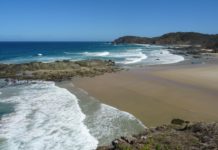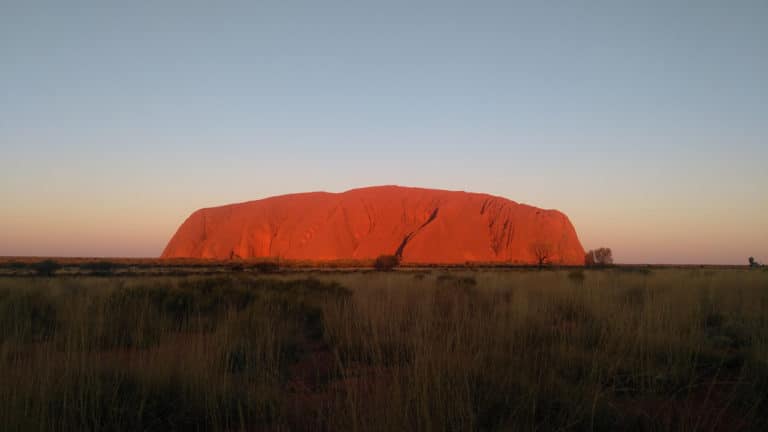
Uluru (Ayers Rock) is undoubtedly one of Australia’s most famous landmarks. At 550 million years old, this big rock stands at 348 meters and is more than 9 km in circumference. A true emblem of the country, the monolith of vibrant colour stands spectacularly in the middle of the Australian desert. Whether you want to get close to the incredible geological formations of the park by taking one of the many hiking trails or simply admire their changes of colour at sunrise or sunset, you are guaranteed to be blown away by its splendour.
Table of Contents
Ayers Rock or Uluru?
The rock was called Uluru long before Europeans arrived in Australia. Uluru is the correct name from the language Pitjantjatjara and has no English translation.
Explorer William Gosse became the first non-Indigenous person to see Uluru in 1873. He then chose to name the rock Ayers Rock in honor of Sir Henry Ayers, the Premier of South Australia at the time. Ayers Rock was the most commonly used name until 1993, when the rock was officially renamed Ayers Rock / Uluru – the first site in the Northern Territory to have received a dual name. A sacred mountain for the Aboriginal people (the Anangu, who are also the owners), Uluru is the main attraction of the UNESCO World Heritage-listed Uluru-Kata Tjuta National Park.
Uluru derives its name from its Aboriginal designation; it is a proper name from the Pitjantjatjara language that does not have an English translation.
In 2002, these names were reversed at the request of the Regional Tourism Association of Alice Springs, and the rock took on the official name of Uluru/Ayers Rock, which it still holds today. Therefore, you can choose to use the name Uluru or Ayers Rock to refer to this place. However, within the national park, the original name (Uluru) is used.
Getting There & Park Entry
Although it may be in the middle of nowhere, Uluru-Kata Tjuta National Park is actually very easy to reach. The nearest town is Yulara, located 20 km before the entrance to the park. This is where you will find all the hotels and tourist facilities for your visit.
By plane
Yulara has its own airport, called Ayers Rock / Connellan Airport (airport code AYQ). You can reach Yulara directly from several Australian cities including Sydney, Melbourne, Brisbane, Darwin, Adelaide and Alice Springs.
If you are coming from abroad or from another Australian city, your flight will probably be connected via one of the cities above. The airlines serving Yulara are Virgin Australia, Qantas and Jetstar.
By bus
If you do not have your own vehicle, it is possible to travel to Uluru or Kata-Tjuta by bus. You can book one of the many sightseeing tours or buy a pass for the hop-on hop-off shuttles run by the Yulara resort. You will not find any taxis or public transport.
From Alice Springs, various bus companies operate daily to Yulara. Like Emu Run (6 hours trip and from $170) or AATKings (6 hours trip, from $200).
By car / campervan / moto
Many visitors arrive at Uluru as part of a road trip in the Australian outback.
Uluru is located 465 km from Alice Springs. It takes about 4.5 to 5 hours to get there, not counting any potential stops. You do not need a 4×4 vehicle to access the national park. The road leading there is paved and in very good condition. You will find gas stations easily along the way.
Finally, it is also possible to rent a car upon your arrival at the airport. However, given that the number of rental cars in Yulara is limited, consider booking a few weeks in advance.
Info: The famous Red Centre Way is a wonderful route that winds through the region. If you choose to take it, it will introduce you to some colorful places. You will have the opportunity to cross the Uluru-Kata Tjuta National Park, Watarrka (Kings Canyon), Tjoritja (West MacDonnell Ranges), and many other worthwhile places (4×4 necessary). You can download the itinerary via Red Centre Way HERE.
🚐 5% Discount with Travellers Autobarn
Travellers Autobarn is offering a 5% discount to Australia Backpackers Guide readers with promo code GUIDEEN
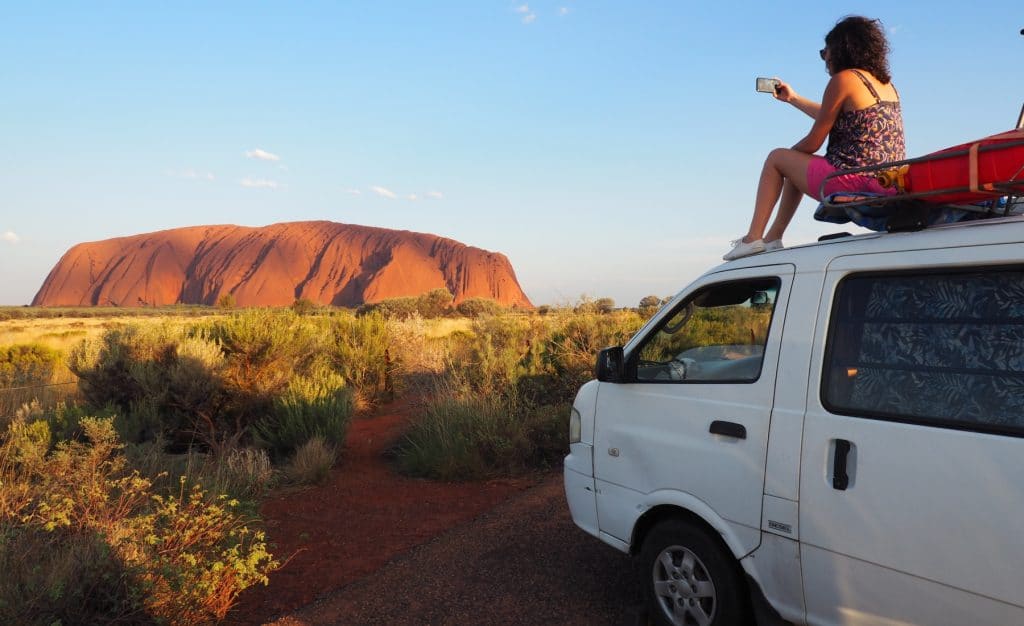
Join a tour
Alternatively, you can choose to visit the park by joining a tour. Uluru Aboriginal Tours is a tour operator run by the Aboriginal community that offers multiple excursions that will allow you to learn more about this mysterious rock. You can also join a tour departing from Alice Springs. Discover the sacred lands of the Aboriginal people, learn the culture and customs of Australia’s oldest people and come back transformed from this unique experience.
It is also possible to take a helicopter flight over the sacred rock, a unique experience! And for the more adventurous, why not try a parachute jump over Uluru? Chills guaranteed! In short, there’s something for everyone !
Park Entry Fee
- AUD 38 per adult (3-day pass)
- AUD 19 per child (5–15)
- Pay online or at Yulara Visitor Centre
Best season to visit Uluru
Uluru and Kata Tjuta are incredible at any time of the year. However, the climate in central Australia does vary season to season.
The best time to visit is between May and September, when the maximum temperature during the day is usually between 20 and 30 ° C. The cool weather makes walking safer and much more enjoyable as it also rains very little during this time. Nighttime temperatures can be very cold in the winter, so ensure to pack warm clothes with you.
August and September are also popular months to visit as you’re able to observe beautiful wildflowers in bloom at the park.
The period from October to March can be extremely hot, with daytime temperatures above 35 ° C. However, the hot weather also brings storms and rain, which can be a major advantage as they fill the water holes and start the Uluru waterfalls which can be spectacular!

Activities to do in Uluru
Hiking
There’s nothing like taking one of the many walking paths to immerse yourself in the natural beauty and rich culture of Uluru-Kata Tjuta National Park. Most trails are wheelchair accessible and the difficulty ranges from easy to moderate.
Mala Walk
This 2 km walk goes from the Mala car park to the Kantju gorge. You can do this free walk, guided by rangers every day. The walk departs at 8 am from October to April and at 10 am from May to September.
You enter the caves where the Mala (red hare-wallaby) camped when they first arrived at Uluru and discover the cave where they prepared their meals. The Malas are the ancestors of Anangu and their story is one of the most important in Tjukurpa.
Admire the beautiful examples of rock art along this walk before arriving at Kantju Gorge, a place of deep peace surrounded by vertical walls.
Base Walk
This walk is 11 km of track which follows a complete tour of Uluru. It is ideal for experiencing Uluru up close and the best way to discover the various plants, animals and geological features of the park.
You can do all of Uluru’s basic walking trails (around 3-4 hours) or simply focus on one of its sections, depending on your time, fitness and weather conditions. We advise you to start the hike from the Mala carpark and go clockwise.
You can also hire a bike from Outback Cycling to tour Uluru. The shop is located right next to the cultural centre. You can also join a Segway tour to discover the rock while having fun.
Note: you will find along this trail, several emergency radios in case you need help (injury or sunstroke) as well as drinking water on the one hand and other of the site.
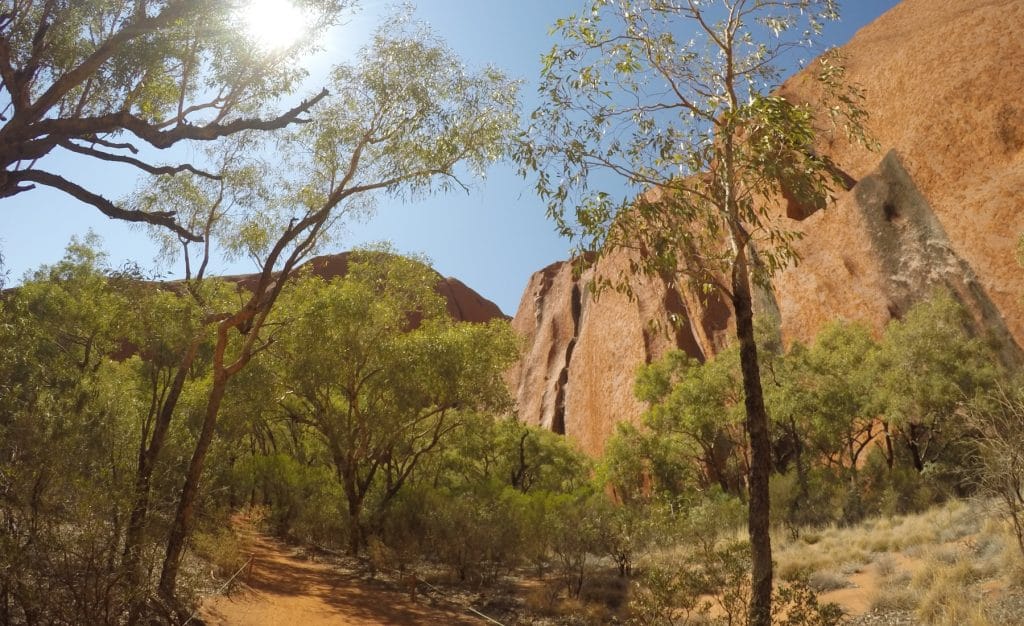
Valley of the Winds (Kata Tjuta)
Your visit to Uluru would not be complete without visiting Kata Tjuta (The Olgas) which is 35 km from Uluru. These rock formations have 36 red sandstone domes reminiscent of giant heads extended over 35km2.
The Valley of Winds walk is a 7 km circuit in the heart of the rocky massif and will offer you breathtaking views. Allow around 3 to 4 hours to complete the entire loop. For a shorter option, you can walk to one of the lookouts and return.
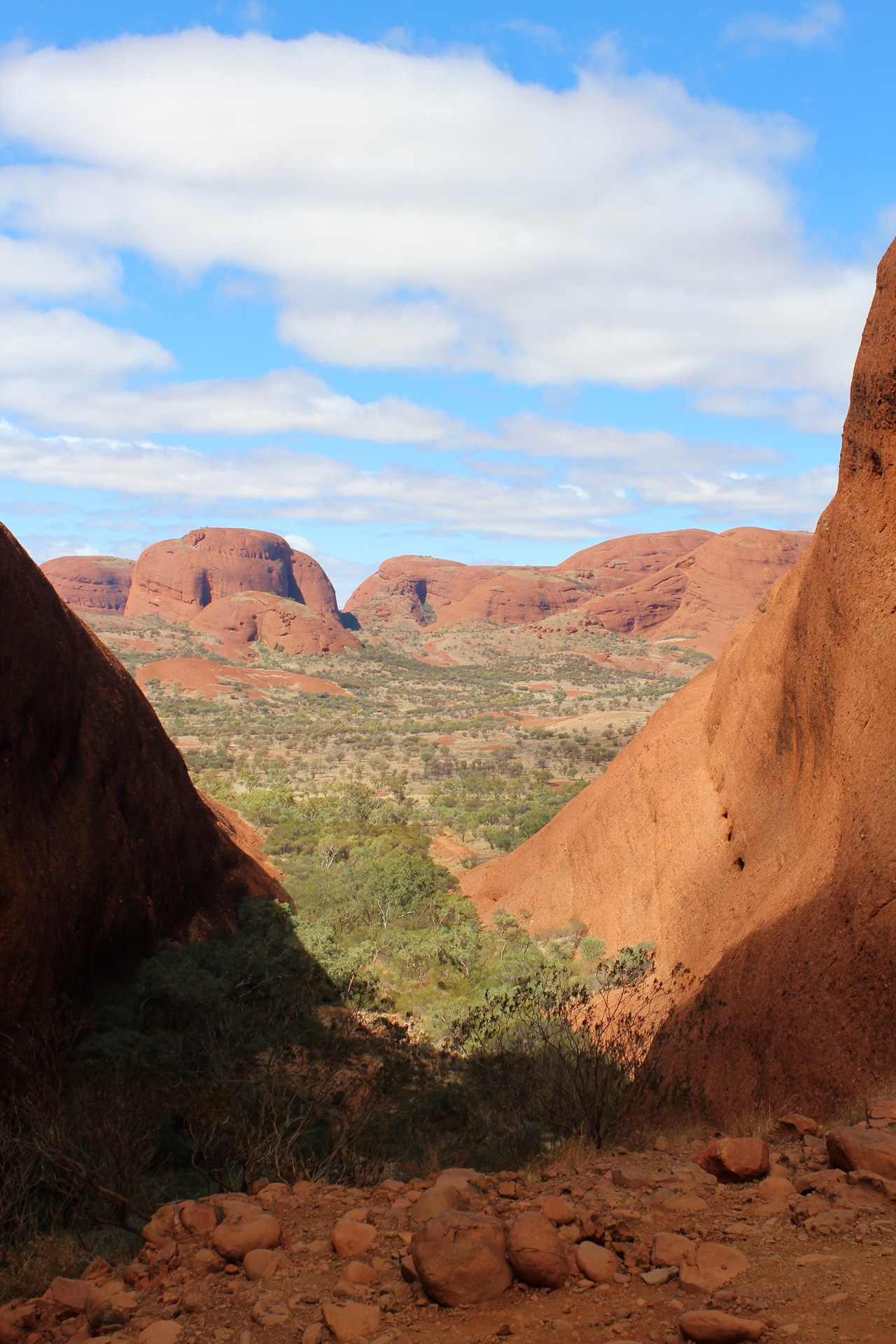
Sunrise & Sunset Viewing
Uluru-Kata Tjuta is known worldwide for its spectacular sunrises and sunsets. As sunlight plays with the landscape, the rock formations change colour before your eyes.
The national park has five observation areas dedicated to the experience and to encourage photography of this beautiful scene. However, there are many other quiet places around the park to admire the sunrise or sunset.
These sunrise and sunset viewpoints are located in such a way that the sun’s rays will hit the rock formations directly at the right time of day to give the impression that the rocks are changing colour. Dedicated platforms at the east and west car parks. Arrive 30 min early for best light and free photo ops.
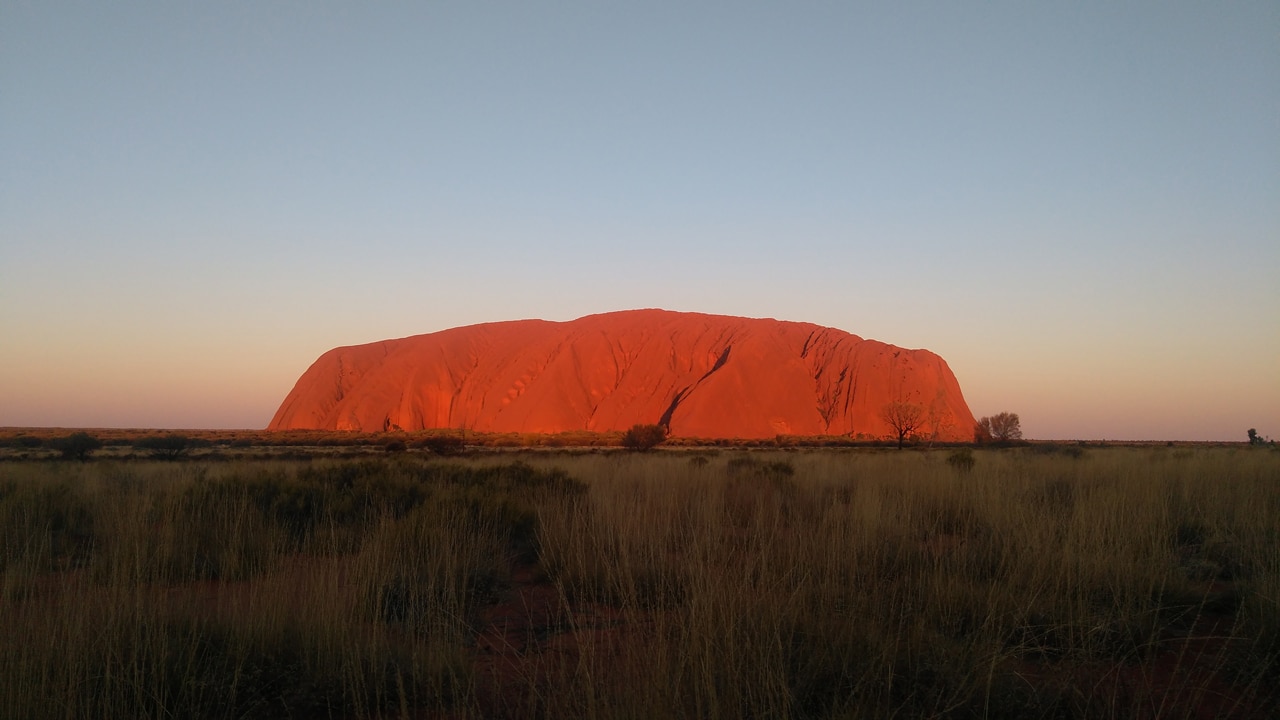
Discovering Aboriginal Culture at Uluru-Kata Tjuta Cultural Center
Begin your trip to the Cultural Center by supporting the local community and deepen your understanding of Uluru-Kata Tjuta National Park. Located 1 km before Uluru, the center is open from 7 a.m. to 6 p.m. every day.
Here, you will learn about Anangu Aboriginal culture and the park’s natural environment through free exhibitions and presentations with the Anangu community and park rangers. There are also displays, a visitor information desk, Aboriginal art galleries and numerous community-owned shops and facilities. Allow at least two hours to explore and fully appreciate the cultural centre.
You’ll also find a visitor information office, Aboriginal art galleries and several community-owned shops. Here you can also sample local coffee or take part in a painting workshop. Allow at least two hours to fully explore and enjoy the cultural centre.
You should also know that there is a festival called “Tjungu Festival” which is celebrated in honor of Aboriginal culture. It is held at the end of April and this for 4 days. You will discover gastronomy, art, music and films.
Respect the prohibition on photography at sacred sites and follow the directions of the Aboriginal people.
💸 10% Discount on your Insurance Policy
Find here all the information you need and get your 10% Go walkabout promo code for any policy.
Where to sleep in Uluru?
The pass to enter the park being valid for 3 days, you will have to find accommodation not far from the national park in order to avoid traveling too much each day and wasting time.
There is no accommodation in Uluru-Kata Tjuta National Park. Attention, it is strictly forbidden to camp in the heart of the national park.
Most of the accommodation (campsite, hotel, apartment, etc.) is located in the Ayers Rock complex in Yulara. The Ayers Rock Campground will offer you all the necessary facilities for a comfortable stay ($45 to $55 without/with electricity in a tent or $185 a night for 2 in a cabin). If you wish for a bit more comfort, you can book either a hotel stay (Desert Gardens Hotel starting from $340 a night for 2 people) or an apartment (Emu Walk Apartments starting from $420 a night for 4 people with one bedroom, count $680 for two bedrooms).
Another option, if you continue to drive on Hwy/State Route 4, less than 1 hour from Yulara, the town of Curtin Springs offers the unique experience of camping on a busy cattle station in full operation.
Dining & Self-Catering
- IGA Supermarket (Yulara): Stock up on groceries to cook at the campground—savings up to 40 % vs. resort restaurants.
- Free BBQ Stations: At the campground and Cultural Centre car park. Bring your own utensils or borrow at the camp office.
- Affordable Eats: Rock-soup café at the Cultural Centre (soups from AUD 8) and burgers at “The Outback Bar & Grill” (from AUD 15).
Aboriginal History and Uluru
The history of Australia’s Aboriginal people dates back over 40,000 years when the continent’s first inhabitants arrived. The Aboriginals were the sole occupants of Australia until the arrival of Europeans in 1788.
The indigenous tribes around Uluru (Ayers Rock) are called the Anangu. This community has inhabited the Uluru region for thousands of years, considering the rock a sacred site.
For many years, the Anangu continued to live traditionally, hunting and living in harmony with nature. However, in the early 20th century, Europeans began to settle in the area and disrupt their way of life.
In the 1950s, the Australian government began establishing reserves for indigenous communities, including the Anangu. This led to the creation of the Uluru reserve in 1958.
It wasn’t until 1985 that the land of Uluru was returned to the Anangu community by the Australian government. It then became the Uluru-Kata Tjuta National Park, now jointly managed by the Anangu and the Australian government.
The sacred site of Uluru is a popular tourist destination, attracting visitors from around the world. The Anangu have worked with the Australian government to establish rules to protect the site while allowing tourists to visit and learn more about their culture and history.
Uluru is a central place in the culture and spirituality of the Anangu. For them, Uluru is a living entity, rich in creation stories known as Tjukurpa. Rock paintings around the rock tell these stories and reflect ancestral traditions.
Also read : Uluru & Kata Tjuta: 2 days Itinerary






















